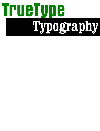
N.B. An asterisk before a word means it has its own entry in the glossary.
- 'kern' table
-
The (optional) part of a TrueType font file where *kerning information is stored. See Apple's spec or Microsoft's spec for the format in detail.
- kerning
-
In traditional metal typography, a kern is the part of a letter that extends beyond the left or right edge of the rectangular type body. Some automatic typesetting machines (e.g. the Monotype) could handle kerned type, but others forced all the character to be within the rectangular body. The Linotype was one of the latter, resulting in many inelegant italic letters - it's the cause of Sabon's many admirable workarounds. Being fragile, kerns could break off if the type was mis-handled.
In digital typography, kerning has a different meaning. The old worry about fragility has disappeared (although some old formats, e.g. *FNT, still restricted the design to the rectangular body); so the italic f can keep its grace. Digital kerning (or, more precisely, "pair kerning") allows the spacing between any pair of characters to be specified, allowing, for example, an r following a T to nestle underneath the right-hand bar slightly, or an LY pair to nudge closer together. It is normally the task of the type designer (or digitizer) to devise all the kerning values. In the days of metal, these adjustments were only possible with extreme labour, and were almost never seen.
In TrueType, pair kerning has always been possible in the 'kern' table, where character combinations are stored with the amount (in font design units) to shift the second character when it comes after the first. Not all applications bother to use kerning information, so the default rectangular body should always be very carefully controlled. Triple-kerning (such as for the occasionally troublesome combination f.") is supported in *OpenType and TrueType *GX.
TYPE*chimérique | TrueType Typography | TYPE*links